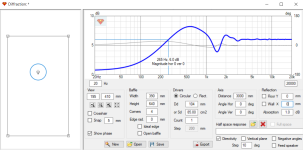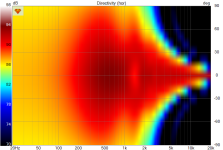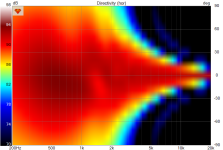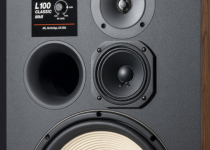Why is it hard to get? Just buy it from an online shop, done.But for US based diy'ers it's hard to get, even with shops like sound import.
understood; I think it's a funny line to draw really. There is bigger step from no router to router, than from router to non- round frame. I'm a bit of a hack myself and often just router in a round hole for the non round driver, sometimes I'll put an aluminum ring on as trim, for proto's usually not.The AC130 doesn't have a round frame, that seemed to matter to some.
I have bought a few things from Soundimports and the shipping to the US was very reasonable. However, I also have a speaker-building problem. I think most people in the US, choosing to build a budget build, would be hesitant to create an account and order from Europe. [Note, I recognize this is somewhat an "American" problem, but I'm just stating the facts even if I don't agree.]Not sure what you mean by "unavailable in the US", or how that would be relevant. It's also not available in Switzerland or Liechtenstein. Not sure about Vanuatu 😉. If there's no-one selling it where you live, just buy it somewhere else....
A couple notes on shipping that I have tried to keep in mind. I don't know what shipping within Europe is like, is there free shipping at certain values?...
You can get the Scan drivers for USD 54 from SoundImports.eu, which is well withing the cost limit indicated by ...but we need to compare prices excluding VAT/taxes/shipping to make it even).
In the US, Parts Express has free shipping on orders over $100 and Madisound has free shipping on orders over $120. If that is not the case in Europe, then some estimate of shipping should be added to the euro price to keep things comparable. For example, I can get a pair of Scan-speak 15W/8434G00 from Madisound for $79 x 2 = $158 (€152) - shipped to me but excluding tax. What would it cost to get a pair shipped within Europe from Soundimports?
US Shipping to Europe. I have never shipped to Europe but looked into it earlier in the week and it looks prohibitively expensive.
Interesting. Why is this?most people in the US, choosing to build a budget build, would be hesitant to create an account and order from Europe.
There is no real difference between US and Europe or anywhere else. Some shops offer free shipping, some don't.I don't know what shipping within Europe is like, is there free shipping at certain values?
The one exception I see is shipping from US to abroad (not the other way), which tends to be notoriously expensive for no obvious reason.
As with the ubiquitous TPA3255 budget amps right now, distortion measurements are OK; they make sound yes. But that's about it.An interesting point. Could also be a good thing in the right circumstances?
As with the ubiquitous Sabre budget DACs right now, distortion measurements are OK; they make sound, yes. But that's about it.
Similarly, can't put it into words, but the music never really comes to life with the SB15NRX. A completely immemorable driver. Then again, I'm also not a fan of the HDS tweeter, and I'm not alone in that, either!
I guess I can only say that even if it's cheaper than some other choices, the mid driver choice for this design should not be marmite!
Careful, them's fighting words! 😛I guess I can only say that the mid driver choice for this design should not be marmite!
Have you ever seen a grup of purchasing directors trying to design a loudspeaker... breaking news !🤣
Ac 120 and 130 are wonderful drivers, but expensive. Similarly to Wavecor, all well above 100 euros in Europe
It is definitely possible. Using the inductor and capacitor for a textbook LR2 low-pass at 250Hz vs 400Hz, choosing the cheapest options at Parts Express, the 250Hz is $15 more expensive for a pair of speakers. If the target price of drivers is $300, this extra $15 just for 2 components per speaker is 5% of the cost of the drivers. Not saying that will be the case in reality, but for a budget build when the xo is really getting to that final version...a notch or lower crossover point(s) can make a difference....Is there so much price difference between two coils with a XO at 250 Hz and 500 Hz ???? ...
But, I also believe in letting the drivers / cabinet / measurements dictate the xo - so we will just deal with these issues when they come.
Although the BC25 is very low cost and measures reasonably well by standard sine sweep, some people don't like the sound of it. ? @wolf_teethNo, there is a very simple and effective solution, but as always, too many cooks spoil...
Should the tweeter be a little pricier than that one, there is Dayton DC28FT (truncated to compliment hds),
- Peerless BC25TG15-08, $15.69 (30€)
- SUBTOTAL 1 pair=$262 (370€)
or better.
Here is a recording of the BC25 vs 2 other tweeters reasonably low cost tweeters (US$160 a pair, US$50 a pair) playing the same music clip
All have had a LR4- 2KHz high pass filter applied.
Have a listen to all 3, and see what you think is most transparent (least grit, noise, pops, clicks, Barkhausen effect, IMD etc)
For pinching pennies and finding at tweeter to fill a 104mm hole, I think it is OK, but certainly if you listen to these 3 clips, you might agree that are better sounding tweeters...
Let us try to focus on sonics first, then decide on availability, and affordability.
Recordings courtesy @DcibeL
Attachments
With respect, I struggle with the comparisons and the logic. We also should be credited with having control over what a driver does 😉As with the ubiquitous TPA3255 budget amps right now, distortion measurements are OK; they make sound yes. But that's about it.
As with the ubiquitous Sabre budget DACs right now, distortion measurements are OK; they make sound, yes. But that's about it.
Similarly, can't put it into words, but the music never really comes to life with the SB15NRX. A completely immemorable driver. Then again, I'm also not a fan of the HDS tweeter, and I'm not alone in that, either!
I guess I can only say that even if it's cheaper than some other choices, the mid driver choice for this design should not be marmite!
Let me give an example of these subjective judgements.. when we brace a cabinet and feel the sound has become boring and lifeless. We've spent time researching the process and used the best materials.
It's a good thing in disguise, yet the first impression is a depressing one. It takes time and hard work to balance other issues around it to embrace the non-resonant sound. Apparently, resonant sound covers a multitude of sins.
In regards to the crossover frequency for the midrange, this is what the baffle will do with a 5" cone (Simulator assume flat piston device, this user entered~ Sd= 85cm^2 for ~5.25" device)

2 things to note-
1. The baffle step loss starts from ~265Hz- to avoid loss of SPL eg. using a midrange with just 87dB/2.83V , we would want to cross above this frequency
2. The baffle causes a gain in SPL up to past 1KHz, followed up a dip and a peak. The crossover will have to deal with this, but the 2dB dip at ~1.4KHz will be difficult to deal with.
Here is the directivity-

If we offset the midrange, then the on-axis dip and peak is not as severe (-1/+0.5 dB).

On the other hand, the directivity is asymmetric (unsurprisingly)

Trade-offs...
2. On the subject of choosing circular driver or those with unusual frames, what makes the most difference is flush mounting the tweeter, due high frequencies <-> small wavelengths involved.
Not flush mounting the midrange or woofer is OK. This was documented many years ago by Zaph here:
For those who would like to see what the big brands are doing for US$4000/pair:


2 things to note-
1. The baffle step loss starts from ~265Hz- to avoid loss of SPL eg. using a midrange with just 87dB/2.83V , we would want to cross above this frequency
2. The baffle causes a gain in SPL up to past 1KHz, followed up a dip and a peak. The crossover will have to deal with this, but the 2dB dip at ~1.4KHz will be difficult to deal with.
Here is the directivity-

If we offset the midrange, then the on-axis dip and peak is not as severe (-1/+0.5 dB).

On the other hand, the directivity is asymmetric (unsurprisingly)

Trade-offs...
2. On the subject of choosing circular driver or those with unusual frames, what makes the most difference is flush mounting the tweeter, due high frequencies <-> small wavelengths involved.
Not flush mounting the midrange or woofer is OK. This was documented many years ago by Zaph here:
For those who would like to see what the big brands are doing for US$4000/pair:

Last edited:
HDS midwoof friendly !
Yes, -6dB loss for the woofer at 4Pi and - 2 db loss for the midwoof or more according baffle position for it.
If the NE149W-08 popups again, putting it near the edge almost flatten its 700 Hz to 1250 Hz plateau bump you see on the datasheet. Final behavior migth be different though between the IEC baffle and the 38/40 cm width front baffle of the cabinet
Yes, -6dB loss for the woofer at 4Pi and - 2 db loss for the midwoof or more according baffle position for it.
If the NE149W-08 popups again, putting it near the edge almost flatten its 700 Hz to 1250 Hz plateau bump you see on the datasheet. Final behavior migth be different though between the IEC baffle and the 38/40 cm width front baffle of the cabinet
We aren't completely ruling out non-round drivers, just that there is a preference for round due to ease of build. If the best speaker choice is not round, that is fine. If there are two speakers that we are indifferent about and one is round and one is not, it makes sense to use the round one.....I think it's a funny line to draw really.
I was the first to bring up the AC-130, I have it on hand and know it's not round. If it was inexpensive in Europe it would probably be high on our list.
Member
Joined 2003
To be clear, the BC25 here is the BC25SC06, the little neo horn loaded one. It also wasn't a very "Scientific" comparison. The BC25SC06 is quite high sensitivity, tested at the same voltage it's actually playing quite a bit louder than it's competitors in this test. In any case, for this test at 2.8V, it didn't cope well with a 2kHz LR4 high pass very well, I would cross higher with this one.Here is a recording of the BC25 vs 2 other tweeters reasonably low cost tweeters (US$160 a pair, US$50 a pair) playing the same music clip
Recordings courtesy @DcibeL
Last edited:
Some comments below before adding Design Goals to Post #1. Feel free to add comments or disagree with mine.
I would not include maximum external dimensions yet as it doesn't affect any current choices. I have mocked up some dimensions based on several of the midrange drivers we are considering, the SLS 12" and some target volumes based on it's TS parameters and I get some reasonable version an inch or two bigger than the above.
I would not target 4 ohms nominal impedance. If we NEED a 4-ohm midrange that is fine, but most of the 8-ohm drivers under consideration work fine and I would think an 8-ohm would guarantee more amplifiers will drive it. On the other hand, if we were targeting 8-ohm impedance we would need to specify that, as it would rule out some drivers.
I think this should be discussed. I know it has been mentioned but it has also been disputed. I believe the original reasoning was based on the typical use-case of the Classic 3-ways of the 70s and 80s. I have no personal preference, but think we should have a conversation on this goal.
Something like this?
...
• The external volume should not be larger than 92L / 3.25 cu ft. (64 x 39 x 37 cm; 25 x 15 1/3 x 145/8 ") => 70L internal volume if using 3/4" stock.
I would not include maximum external dimensions yet as it doesn't affect any current choices. I have mocked up some dimensions based on several of the midrange drivers we are considering, the SLS 12" and some target volumes based on it's TS parameters and I get some reasonable version an inch or two bigger than the above.
• The BC3W shall have have 4 ohm nominal sensitivity, and designed to be used with affordable amplifiers/AV receivers with 100W 4 ohms
I would not target 4 ohms nominal impedance. If we NEED a 4-ohm midrange that is fine, but most of the 8-ohm drivers under consideration work fine and I would think an 8-ohm would guarantee more amplifiers will drive it. On the other hand, if we were targeting 8-ohm impedance we would need to specify that, as it would rule out some drivers.
• The speaker shall be designed such that the front to the wall should be less than 2 ft to ensure that frequency output is not reduced.
I think this should be discussed. I know it has been mentioned but it has also been disputed. I believe the original reasoning was based on the typical use-case of the Classic 3-ways of the 70s and 80s. I have no personal preference, but think we should have a conversation on this goal.
4" vs 5"
I have mentioned that I prefer a 5" for aesthetic reasons. A few people agree, but it really has not been discussed much.
If we select a capable 4" driver, the two main differences (other than aesthetics) I see are the wider dispersion and providing more flexibility for the tweeter choice. The wider dispersion was simulated in post # 549.
From a technical performance viewpoint, how important is this difference in directivity? There is no "right" answer about directivity, what do people think is a better choice, slightly wider dispersion or slightly narrower dispersion?
I have mentioned that I prefer a 5" for aesthetic reasons. A few people agree, but it really has not been discussed much.
If we select a capable 4" driver, the two main differences (other than aesthetics) I see are the wider dispersion and providing more flexibility for the tweeter choice. The wider dispersion was simulated in post # 549.
From a technical performance viewpoint, how important is this difference in directivity? There is no "right" answer about directivity, what do people think is a better choice, slightly wider dispersion or slightly narrower dispersion?
- Home
- Loudspeakers
- Multi-Way
- Budget Classic 3-way Discussion Thread